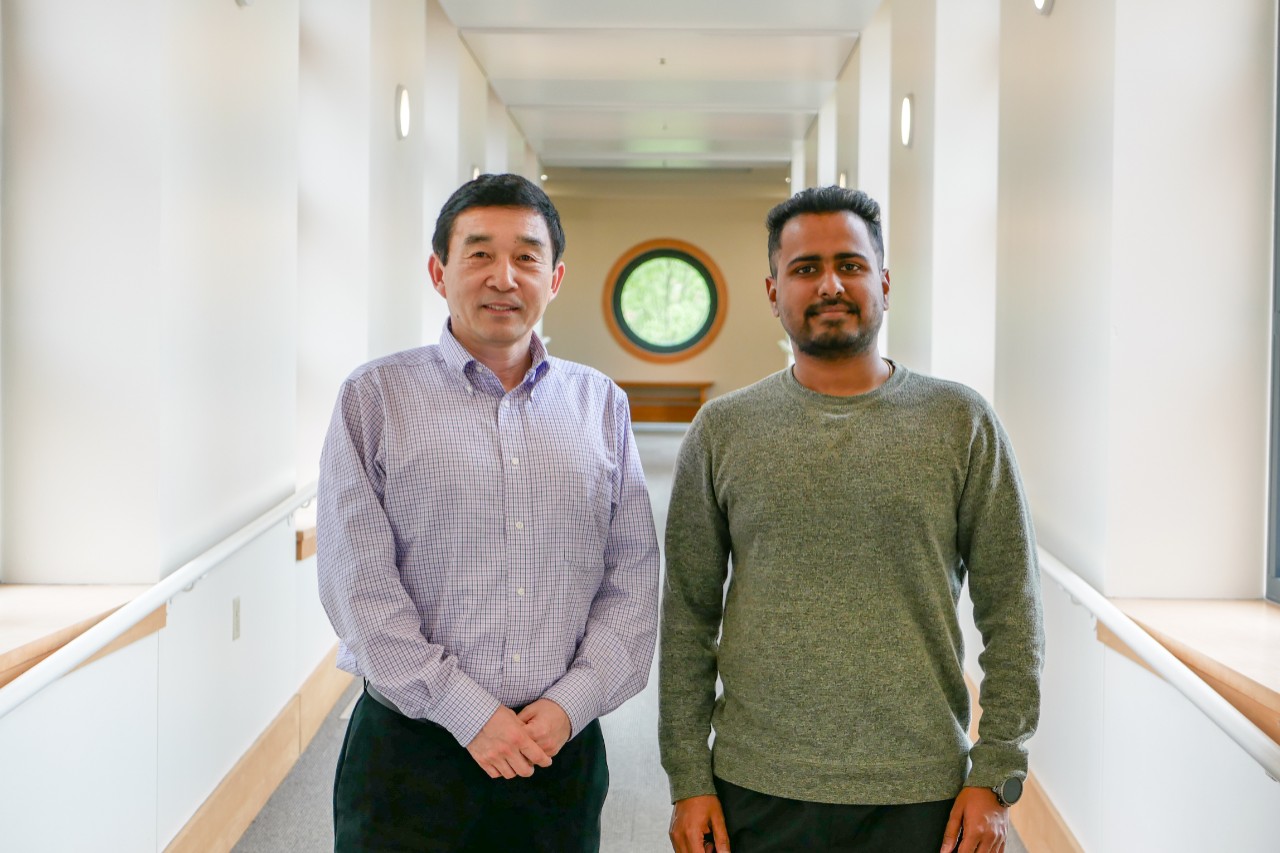
UC reduces traffic with connected vehicle research
Last year the average American spent nearly 100 hours sitting idle in traffic, according to a 2018 report by INRIX. Researchers at the University of Cincinnati are making up for lost time.
UC professor of intelligent transportation engineering Heng Wei created a model and algorithm that uses data from connected vehicles to adjust the timing of traffic lights. If applied commercially, the system can reduce traffic across the country.
Wei advised his graduate student Gaurav Kashyap to transform the idea into a computer simulation. The research now forms the core of Kahyap’s master’s thesis.
“We are not just looking at one specific scenario. We are looking at the whole picture,” Kashyap said. “The uniqueness of this research is it can be implemented in any particular situation.”

UC professor of intelligent transportation engineering Heng Wei discusses his project. Wei created a model and algorithm that uses data from connected vehicles to adjust the timing of traffic lights. Photo/Corrie Stookey/CEAS Marketing
Kashyap defended his master’s thesis proposal last week and will spend the next several months finding additional applications for the algorithm. The works reflects the urban impact platform of UC’s strategic direction, Next Lives Here.
Conventional traffic lights are either pre-timed or actuated. If you’ve ever been stuck at a red light late at night, the inefficiency of this system is frustratingly obvious.
These conventional detectors are faulty, said Wei. They’re exposed to the elements and can wear down over time. Rain and snow can obscure camera lenses and cracks in the ground can disrupt underground sensors.
We are not just looking at one specific scenario. We are looking at the whole picture.
Gaurav Kashyap, UC graduate student

UC graduate student Gaurav Kashyap discusses processing raw data from connected vehicles into one unit, the topic of his master's thesis. Photo/Corrie Stookey/CEAS Marketing
Instead of focusing on these sensors, Wei and Kashyap looked to wireless technology embedded in connected vehicles. Connected vehicles work a lot like phones that have GPS. The vehicle gives off information like location, speed and acceleration that can be useful in adjusting signals to match traffic flows.
Traffic controllers currently receive this data but don’t always know what to do with it. Wei and Kashyap created an algorithm that changes that.
“This is a comprehensive network that takes all the raw data and processes it into one unit,” said Kashyap. “From there we can determine the traffic state and optimize signal timing.”
In addition to processing the raw data from individual connected vehicles, the algorithm processes data on traffic flow, which includes information like density, spacing, arrival and departure rate and car size.

UC graduate student Gaurav Kashyap and his advisor UC professor Heng Wei focus on wireless technology embedded in connected vehicles to adjust the timing of traffic lights. Photo/Corrie Stookey/CEAS Marketing
The roadside device, which is part of a larger field called intelligent infrastructure, is better than current detectors in several ways, Wei said.
Unlike a pre-timed device, the roadside device receives data and changes the signal based on traffic flows in real time. Also, rather than focus on a road’s single point, the device captures data from individual cars approaching and leaving an intersection at any location.
Wei and Kashyap have established a proof of concept for their algorithm. They are applying for a patent and hope to eventually publish their findings. They’re optimistic for its potential commercial uses, especially because the algorithm can be applied to any intersection.
“We wanted to be as realistic as possible,” said Kashyap. “This project is achievable. It improves the existing infrastructure and it makes the existing technology better.”
Featured image at top: UC professor Heng Wei, left, and UC graduate student Gaurav Kashyap are exploring ways to use data to reduce traffic. Photo/Corrie Stookey/CEAS Marketing
The Future of Transportation
See more coverage of innovative transportation work at UC:
UC students present future of transportation at forum
Next Lives Here
The University of Cincinnati is classified as a Research 1 institution by the Carnegie Commission and is ranked in the National Science Foundation's Top-35 public research universities. UC's graduate students and faculty investigate problems and innovate solutions with real-world impact. Next Lives Here.
Related Stories
UC student breaks world record in competitive speedcubing
December 19, 2025
UC computer science student Sujan Feist set a new world record in speedcubing at competition this month in Coshocton, Ohio. Feist is the reigning world champion in the 2x2 division.
UC undergraduate collaborates with Swiss university on drone research
December 19, 2025
Prissha Chawla, undergraduate student at the university of Cincinnati, is double majoring in computer science and statistics at the College of Engineering and Applied Science and College of Arts and Sciences. Now preparing to graduate in the spring of 2026, Chawla’s journey at UC has been full of impactful experiences. Since she arrived, she has had the opportunity to participate in a new international exchange program with a university in Switzerland, present at an international conference in Prague, co-op with Delta Air Lines, and much more.
PhD student uses engineering to understand cardiovascular system
December 17, 2025
Drawn to the University of Cincinnati for the strong reputation in cardiovascular research and the connections with the UC Medical Center, Shrayesh Manegaonkar is pursuing a PhD in mechanical engineering at the College of Engineering and Applied Science. Recently, he was named Graduate Student Engineer of the Month for his work on biofluid mechanics, aiming to develop better diagnostic tools for cardiovascular diseases.
